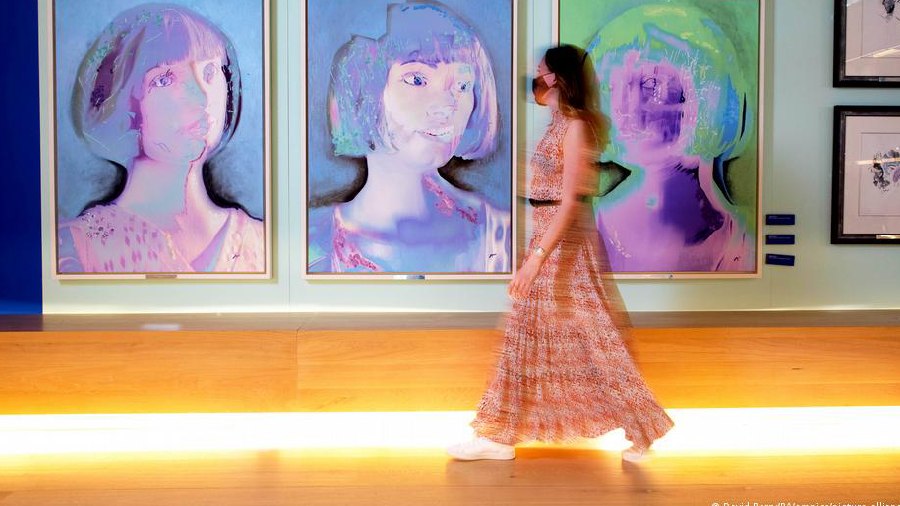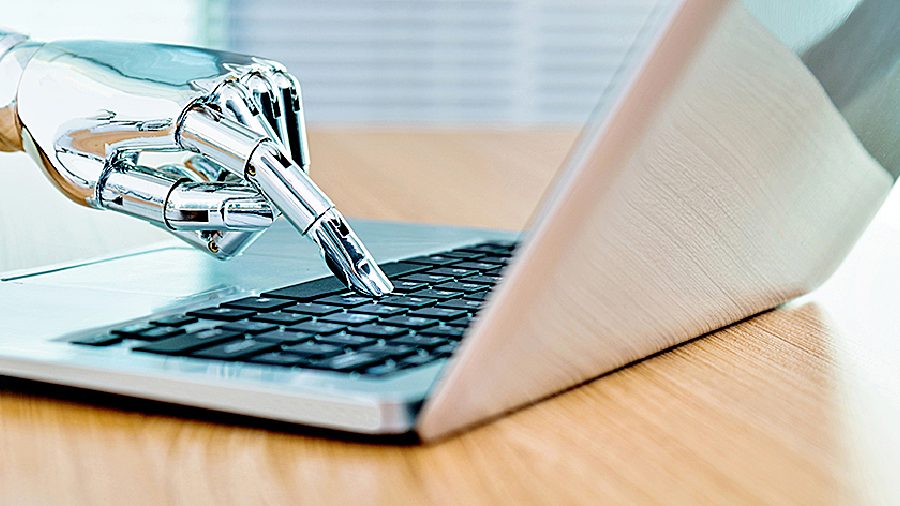Australian singer Nick Cave came out strongly against an AI-generated track "in the style of Nick Cave" sent to him in January by a fan. It is "bullshit," said Cave.
Meanwhile, three female fine artists recently filed a class action lawsuit in the US against several AI companies, charging them with theft of creative ideas.
There's no doubt that artificial intelligence is making its way into the art world. While the consequences remain uncertain at this early stage, artists are already concerned about the appropriation of their intellectual property.
Will AI forever change art?
Nonetheless, the art market has begun to do business with AI art as algorithm-generated works feature in museum exhibitions. But how will AI change creative expression itself?
Ai-Da is the world's first humanoid robot artist to draw and paint with the help of AI and caused a sensation when it created works at the 2022 Venice Art Biennale.
Algorithms process the information and let the robot's arm draw portraits of people. Ai-Da's creator, Aiden Miller, developed her with a team of computer scientists, robotics experts and designers. Each of Al-Da's works is unique. But is it creative?
Here come the robots
The Vitra Design Museum near Basel named its current exhibition about the relationship between man and machine, "Hello, Robot."
"What fundamentally interests people in robotics and artificial intelligence is the very old human longing to play God," says curator Amelie Klein.
Her show features a robot that writes manifestos. "This robot is dumb as a box of rocks," she explained. "It knows three languages, vocabulary, grammar, syntax, but it doesn't understand what it's writing," Klein told DW.
While Robots, androids and artificial intelligence have long been a feature of sci-fi films, from "Metropolis" to "Blade Runner" and "Matrix," can AI progress to feel emotions and realize art?
Not any time soon, according to Vitra Design Museum director, Matteo Kries, who insists that "the machine cannot feel emotions."
'This song sucks'
Nick Cave would agree. The chorus of the AI-generated song a fan sent him in a Nick Cave "style" is not quite poetry.
"I am the sinner, I am the saint, I am the darkness, I am the light, I am the hunter, I am the prey, I am the devil, I am the savior."
Cave posted a response on his website, explaining why he feels the ChatGPT-generated song is "bullshit" and a "grotesque mockery of what it is to be human."
AI might be able to write a speech, essay, sermon or obituary, but not a "genuine" song, Cave says.
"Songs arise out of suffering, they are predicated upon the complex, internal human struggle of creation."
"Algorithms don't feel, data doesn't suffer," Cave writes.
When machines dabble in art
When a brand-new Rembrandt appeared on the scene in the Netherlands in 2016, it was an "in the style of the Dutch master" AI-created work fed with data from 346 actual Rembrandt paintings.
The countless algorithms that calculated the image were created by a team of programmers and scientists from Delft University of Technology, and Microsoft AI experts.
Two years later, an AI-generated work of art achieved a respectable sale for the first time. A portrait named Edmond De Belamy, created by an algorithm fed with 15,000 paintings from different eras, was auctioned at Christie's auction house in New York for $433,000 (€397,000).
The French creative collective Obvious provided an entirely fictional De Belamy family tree, a golden frame — and instead of the artist's signature, the algorithmic formula.
What AI programs like Midjourney, Dall-E and Stable Diffusion can do for images, Chat GPT developed by Open AI can do for text content. It conducts conversations, answers questions, and composes texts of various kinds on demand. Students increasingly use the software.
Who is the author?
Who owns a work generated by a machine that has been fed with millions of — copyrighted — images and texts? Who is the originator of the creation? Is the AI the author, or are the programmers? Perhaps Picasso, Rembrandt or Van Gogh and the artists and writers whose works provided the data for the machine?
Vitra Design Museum director Kries does not believe artificial intelligence will eventually replace the emotional aspect of art and creativity.
Vinzent Britz, art director, motion designer and lecturer at Berlin's College of Fine Arts, compares the current situation to the transition from classical painting to photography.
Before photography became an established art form, "there was resistance, people said that's not art, that's a photo, that's plagiarism," Britz told DW. He expects a similar development in the case of artificial intelligence.
Making AI 'fair and ethical'
The three artists — Sarah Andersen, Kelly McKernan and Karla Ortiz — that have filed a class action lawsuit against Stability AI, Midjourney and the Deviant Art platform seek damages and an "injunction to prevent future harm."
Their attorney Matthew Butterick writes on his website that the lawsuit is "another step toward making AI fair and ethical for everyone."
It seems there is still a long way to go.












